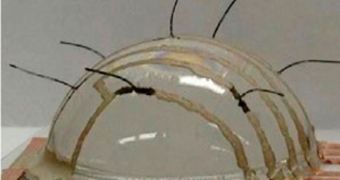Using funds from the US Defense Advanced Research Projects Agency (DARPA), researchers at the Department of Energy's (DOE) Lawrence Berkeley National Laboratory (Berkeley Lab) and the University of California in Berkeley (UCB) were recently able to develop electronic whiskers.
These structures, made up of carbon nanotubes and silver nanoparticles, could soon enable robots to experience their surroundings with the same level of precision a cat uses to sniff out its environment.
Nanotechnology research has already produced electronic skin and electronic eye implants, so one could argue that whiskers are the next step in this trend. The newly-developed tactile sensors feature composite nanostructure films, and can respond to a single Pascal of pressure easily.
A Pascal is roughly equivalent to the pressure exerted on a tabletop by a single dollar bill. With this level of precision, robots could gain more insights into their environments, bringing the goal of them working safely side-by-side with humans even closer to reality.
The study was led by Berkeley Lab Materials Sciences Division (MSD) faculty scientist Ali Javey, who also holds an appointment as a professor of electrical engineering and computer science at UCB.
“Whiskers are hair-like tactile sensors used by certain mammals and insects to monitor wind and navigate around obstacles in tight spaces,” says the expert. Details of the investigation were published in a recent issue of the journal Proceedings of the National Academy of Sciences (PNAS).
“Our electronic whiskers consist of high-aspect-ratio elastic fibers coated with conductive composite films of nanotubes and nanoparticles. In tests, these whiskers were 10 times more sensitive to pressure than all previously reported capacitive or resistive pressure sensors,” he goes on to say.
Javey and his group started the work by using a carbon nanotube paste to create a network matrix with excellent electrical conductivity properties. This structure was also able to bend in multiple directions effortlessly. A thin silver nanoparticle film was then added to this matrix to make it more sensitive to mechanical strains.
“The strain sensitivity and electrical resistivity of our composite film is readily tuned by changing the composition ratio of the carbon nanotubes and the silver nanoparticles. The composite can then be painted or printed onto high-aspect-ratio elastic fibers to form e-whiskers that can be integrated with different user-interactive systems,” Javey explains.

 14 DAY TRIAL //
14 DAY TRIAL //